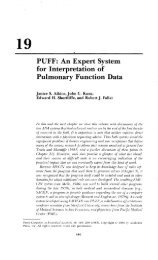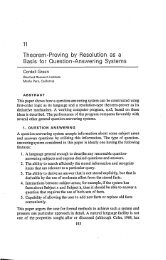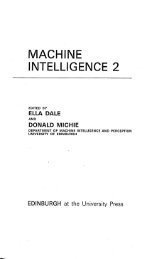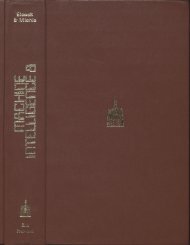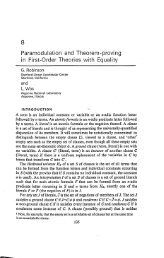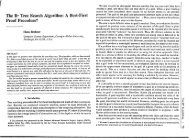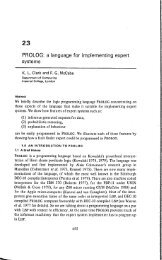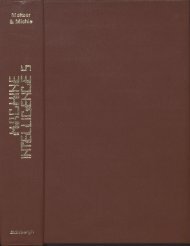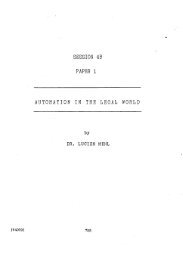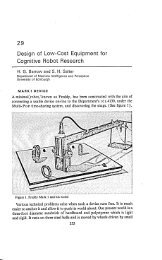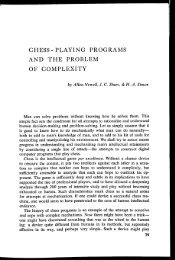Medical diagnosis and cybernetics - AITopics
Medical diagnosis and cybernetics - AITopics
Medical diagnosis and cybernetics - AITopics
You also want an ePaper? Increase the reach of your titles
YUMPU automatically turns print PDFs into web optimized ePapers that Google loves.
SESSION 4APAPER 4MEDICAL DIAGNOSIS AND CYBERNETICSbyDR. FRANCOIS PAYCHA(94009) 635
BIOGRAPHICAL NOTEDr. Francois Paycha, born at Narbonne, studied medicineat the University of Montpellier. His first researcheswere concerned with the embryology of the eye, laterusing the distribution of radioactive phosphorus P32 tostudy the structure of the tissues <strong>and</strong> for the detectionof tumours.He was then appointed to the National Centre ofScientific Research. While in charge of a hospitalclinic, he noted the considerable differences in thediagnoses of conscientious <strong>and</strong> knowledgeable practitioners<strong>and</strong> those advanced by the hospital. In view ofthe special need for exact <strong>diagnosis</strong> in medicine he madea study of the causes of these differences.After theoretical research, he made the first "<strong>Medical</strong>Memory' in 1953 with the help of Bull <strong>and</strong> later ofI.B.M. He studied the structure of a three-symbol logicwhich is applicable to medical' problems <strong>and</strong> in general.After a year in the service of Prof. G. E. Jayle, heab<strong>and</strong>oned pure research <strong>and</strong> entered industry.(94009) 636
MEDICAL DIAGNOSIS AND CYBERNETICSbyDR. FRANTIS PAYCHASUMMARYI am going to analyse briefly, <strong>and</strong> describe, the logical structure ofMedicine.On the basis of this study, I shall show how the results thus obtainedmay be wholly applied to other subjects.Then I shall state in detail how <strong>and</strong> why certain branches of activityrecognize other forms of logic.Lastly, I shall show how one may conceive a general system of logic,which is normative, but only in terms of the nature <strong>and</strong> development of eachscience, regarded as a special case of a general rule.A convenient <strong>and</strong> concise way of introducing to Medicine those versed invarious other subjects, is to outline its history. This will be brief <strong>and</strong>incomplete, giving no names or different stages (which would be too .Involved), my principal aim being to show the individual character ofMedicine.This form of presentation is necessary in order to make the nature ofMedicine clear to those who have had treatment because the patient does notsee things in the same light as the doctor.HISTORY OF MEDICINEThe first man or woman to pour fresh water an a painful wouhd was performingthe first piece of therapy by that act; <strong>and</strong> the first man or womanto became aware of the approaching demise of a fellow-creature thereby madethe first prognosis.The desire to relieve pain is probably as old as the world itself, <strong>and</strong>concern with suffering undoubtedly dates just as far back.. (94009) 637
Regarded in this way, on the basis of human suffering, Medicine Isprobably the oldest of the sciences.In the beginning, its aims were unformulated, its activities undirected,but it has since become a discipline governed by the desire to relieve pain.Medicine has gradually dissociated itself - though incompletely as yet -from magic, voodooism <strong>and</strong> superstition; in short, from a series of practices- highly irrational, to say the least - whose existence was justifiedby the ineffectiveness of the drugs which the "doctors" (they must be giventhis name) used.Some of the first practitioners turned their activities towards the makingof drugs, but their work soon became out of date; the secrecy with whichthey surrounded their ridiculously ineffective recipes <strong>and</strong> the naivecharacter of those which have been h<strong>and</strong>ed down to us - likewise very ineffective- now only have an anecdotal value. Nowadays our attention is directedironically enough, much less to the drugs themselves than to the phials <strong>and</strong>bottles which contained them <strong>and</strong> which are the delight of archaeologists.'Others, more moderate in their aims wished to know about the diseases ofman before endeavouring to cure him. Today, the nosological framework oftheir descriptions seems vast, tenuous <strong>and</strong> shapeless; but the slender threadof their clinical observation, made two thous<strong>and</strong> years ago, still remainsvalid today <strong>and</strong> is recorded in its entirety in the huge network of innumerablesubjects <strong>and</strong> interrelationships forming our present knowledge.We can already perceive the division which is going to take place. Evenin the time of Hippocrates, it was difficult for one brain to know everything,for one man to do everything, <strong>diagnosis</strong> as well as therapy.Gradually .this tendency took hold, <strong>and</strong> nowadays we have two distinctbranches, both equally indispensable: medicine <strong>and</strong> pharmacy.In passing, stress must be laid on this process whereby a single disciplinesubsequently divides.into.two or sometimes several different parts,under the pressure of increasing complexity of the relevant data.In this study, we shall consider Medicine <strong>and</strong> Pharmacy as a whole.Medicine, then, is a discipline defined by its particular aim of curingthe sick, It is this aim which governs the activities of the doctor in termsof opportunities for action, thus all methods <strong>and</strong> all techniques arejustified.It must be noted, however, that such definitions, made <strong>and</strong> presented "aposteriori", do not correspond to any logical arrangement within thediscipline.It is the aim which gives it its unity; the purpose of Medicine is tocure.(94009) 838
HOW IS MEDICINE PRACTISED?This ancient branch of knowledge is represented by the medical practitioner;we shall therefore establish the logical structure of Medicine bystudying his activities.The point where Medicine <strong>and</strong> pain come together is in the consultingroom, where on the one h<strong>and</strong> we have the patient <strong>and</strong> on the other, therepresentative of Medicine, the practitioner.What takes place during the consultation?There are two indisputable facts: at the beginning of the interviewthe doctor knows nothing about his patient except that he is ill, <strong>and</strong> atthe end of it the patient goes out provided with a prescription with whichhe obtains the medicaments to cure him, or intended to do so within thelimits of our knowledge. If we confine ourselves to the traditional system,the consultation consists of various parts, as follows: the questioning,the general examination, palpation, inspection, examination with instruments.When these have been carried out, the doctor makes out a case-sheet which,above all else, must be complete. He makes his <strong>diagnosis</strong>, arranges forfurther examinations, perhaps, <strong>and</strong> prescribes treatment.It must be stressed that in this description, the part devoted to establishingsymptoms is fully developed, but the part leading to <strong>diagnosis</strong>,i.e. to the affirmation that a patient is suffering from such <strong>and</strong> such acomplaint, is skimped. Much emphasis is laid upon the value of a properexamination, a complete record of symptoms, palpation carried out gently<strong>and</strong> correctly, but no indication is given of the way in which all thismaterial is put together.Thus is the point to which I would like to draw attention. To make thestudy easier, we shall transcribe the medical data into cybernetic language.This we shall call all the particulars we have about the patient <strong>and</strong> theailments "information".We shall call all the actions by which the doctor obtains informationabout his patient the "acquisition of information", which thus comprisesthe general examination, palpation, questioning the patient, specialexaminations: in brief, all the serdological <strong>and</strong> laboratory techniques. Inthis connection, we should note that knowledge of a blow on the right sideis just as much a bit of information as a laboratory report stating inductance45 Henries, or a detailed report from the heart specialist.We shall call "Information processing" all the mental processes wherebyuse of the information acquired leads to the affirmation that "this patientis suffering from such <strong>and</strong> such a complaint".It must be noted that for the time being I have merely given cyberneticnames to functions already known for a long time. One may therefore askwhether introduction of these new terms is justified, whether any new contributionis made by this simple change in vocabulary.(94009) 639
. More generally, we must prove the existence of a problem in <strong>diagnosis</strong><strong>and</strong> of therapy - a problem which is far from obvious, especially to themedical practitioner.The latter in fact regards <strong>diagnosis</strong> as a self-evident affirmation; inmost cases he will remark that for centuries diagnoses have been made <strong>and</strong>treatments prescribed, without anyone giving their attention to themechanism, but that the system has, nevertheless, worked. This view of theproblem, which consists in ignoring it, is associated - paradoxicallyenough - with the high professional scruples of the doctor.Let us suppose, in fact, that a practitioner has made a <strong>diagnosis</strong> L <strong>and</strong>prescribed treatment K for a patient; he has allowed for all contingencies<strong>and</strong> all the pathological <strong>and</strong> therapeutic possibilities before arriving atIf <strong>and</strong> L. Thus in all good faith, he does not think that there can be anypossible conclusions other than these.However - <strong>and</strong> in this lies the justification for this study - it hasnever been shown that the nature of Medicine is such that the whole of itcan be known by a single doctor.Indeed, we have already seen, in the brief history given above, howMedicine, or the art of tending the sick, is already divided into twobranches: Medicine proper <strong>and</strong> Pharmacy, <strong>and</strong> it has been so divided for along time. Now during the last thirty years we have seen Medicine propersplit up in its turn into ophthalmology, neurology, pediatrics, geriatrics,obstetrics, gynaecology, oto-rhino-laryngology, <strong>and</strong> so on.And now a new tendency is becoming apparent, a kind of superspecialisation,the result of which is that within each special field, new,independent branches are tending to form, one making a study of <strong>and</strong> treatingbinocular vision, another, phonation <strong>and</strong> so on. Fragmentation of this kindis an excellent thing, in the sense that it leads to a good knowledge ofthe subject concerned; it is justified --<strong>and</strong> this is the important thing -by the multiplicity of data applied.There is an unfortunate corollary to it, however, <strong>and</strong> that is, thedifferent specialists are obliged to ignore the rest of Medicine.Now an ailment is never confined to a single organ, <strong>and</strong> such specialisationineiritably leads to a Medicine of organs, a therapy for organs, neglectingthe essential indivisibility of the human being.How could it be otherwise? The specialist has all his attention, all hisfaculty of memory, all his actions directed towards a tiny sphere ofactivity; he cannot multiply himself by a number corresponding exactly tothe number of specialist fields.We thus reach an impasse, with continued progress in the various branchesof knowledge on the one h<strong>and</strong>, <strong>and</strong> our inability to use them all at once onthe other, while they are all necessary for the proper practice of Medicine.Although specialisation may be a means of study, it cannot be the bestway to making cures.(94009) 640"
After all, the problem would be a minor one if we could be sure that thespecialist could now somehow or other link Up the smallest details in hisown field with the whole of pathology.Now this is by no means the case; already, details are escaping theattention of the doctor within his own special field, <strong>and</strong> he is finding itmore <strong>and</strong> more difficult to keep up with ideas in the wider field.To express this more specifically, we can consider the fact that thereare some 4,785 periodicals published in the world. If we allow for a monthlyissue, with four articles of interest in each issue, anyone who wished tokeep up to date would have to read - <strong>and</strong> remember - some 19,140 articles amonth, or 638 a day. This assumes that by previous study he knows all thebasic works <strong>and</strong> especially that there is no defect in his memory; inparticular, that he never has to re-read a work in order to recall it.The magnitude of these figures alone shows that a problem exists, butthey are confirmed by experience as well. Errors in <strong>diagnosis</strong> occur, unfortunately;we all know of such cases.The doctor is thus faced with the problem of <strong>diagnosis</strong>, <strong>and</strong> every day hesees the difficulties of his work increasing. The logician is faced withthe problem, as well, when he is searching for rules <strong>and</strong> conditions..Considered in this light, the problem is a very general one which, aswe shall see, concerns Medicine solely because it represents a particularaspect of the problem <strong>and</strong> is really that of many different forms of knowledge.INFORMATION IN MEDICINE. NOTATION SYSTEMIt seems that Medicine is "par excellence" a field undergoing continualchange, <strong>and</strong> it seems difficult to reduce it to logical terns. Now it is inno way a question of reducing the very substance of Medicine, clinicalobservation <strong>and</strong> other factors, but very much the opposite procedure ofadapting logical symbols to this complexity.Here, logic is not conceived as a more or less arbitrary order imposed onfacts, but as a way of transcribing these facts so that by considering themas a whole, it becomes possible to bring out laws <strong>and</strong> relationships betweengeneral opinions which have hitherto been hidden.We can give an arbitrary number - any number - to each pathologicalsymptom, provided there is a 1:1 correspondence. To simplify the question,let us suppose that we choose the following series of natural whole numbers:(a) I 2 3 4 5 6Each of these figures then corresponds to a symptom, <strong>and</strong> once the conventionalsymbols have been decided upon, writing the figure 5 corresponds towriting, for example, "headaches in the vertex".(94009) 641
On the basis of this conventional system, we can write an ailment Ai ofwhich a headache in the vertex is one of the symptoms:(b) M= 3, 5, 8, 17Thus in this series in addition to a headache in the vertex we have othersymbols, 3, 8, 17 ....But we can write this ailment N in another way. If we agree to make thesymbol "1" (i.e. the binary symbol 1) express existence so that, for example,if there is a "1" underneath the number "5", the symbol "5" is by definitionpresent, we can write series (a) <strong>and</strong> mark with a "1" underneath, the symbolswhich really are present, for example, in the ailment M:(a) 1 2 3 4 5 6 7 8 17 18 19(b) H= 1 1 1 1We can also agree to indicate with an 0 the absence of a symptom: hencewe get:(a) 1 2 3 4 5 6 7 8 17 18 19 ....(b)M=00101001 1 0 0 ....It is then possible to eliminate the (a) series (which can always befound again easily), the position of each 1 <strong>and</strong> 0 indicating the pathologicalsymptom which they represent.We then get(c) - 0 0 1 0 1 0 0 1 .... 1 0 0With these conventions, which are very simple, if not childish, it willbe easy for us to describe, with a code, all the ailments, in the form ofrelationships, such as (c):N=o 0 0 0 1 1 0 0 1P =011 0 1 0 1 1 1However, we can describe the patients themselves, as well:Mr. K.... = 0 0 1 1 1 0 0 0Mr. H.... = 0 0 0 1 1 1 0 0........For example a person in good health will be represented thus:X = 0 0 0 0 0 0Are we entitled to write in this way?Are we entitled to reduce to logical symbols entities as complex aspathological symptoms? Are we entitled to put on one <strong>and</strong> the same footingsymptoms which are obviously not all of the same value?It seems that we are not - at first sight; <strong>and</strong> this is one of the mostimportant arguments put forward.(94009) 642
Now if we study the question more closely, we find that there are variouscriteria of the value of pathological symptoms. For example, it is perfectlylegitimate for one to give an extremely limited prognostic value to theappearance of a pre-auricular ganglion during an ocular neoplasm, or toattribute great diagnostic value to photophobia in Weeks, keratoconjunctivitis.At the same time, however, it must be borne in mind thatthe appearance of the same pre-auricular ganglion in a case of Parinaud'sconjunctivitis ,is perfectly normal; on the other h<strong>and</strong>, if revealed insyphilitic interstitial kerotitis, the same photophobia would be of no interestfor the purpose of <strong>diagnosis</strong>.Thus we see that the notion of the value to be attached to a symboldepends upon both the criteria envisaged <strong>and</strong> especially the clinical contextof the symbols; <strong>and</strong> this context can only be arranged when the <strong>diagnosis</strong> hasbeen made.Now we have a strange inconsistency here: we would attribute a value tothe pathological symptoms, knowing that this value depends upon the <strong>diagnosis</strong>,<strong>and</strong> we would use this value to make the <strong>diagnosis</strong>.Such a procedure must be rejected, because it uses the unknown factor inproof: the assumption is not the symptoms expressed in terms of a <strong>diagnosis</strong>,but, of course, the symptoms alone.For these reasons, therefore, it is legitimate to use the above system ofnotation.Introduction of a symbol expressing the absence of informationIn addition to the symbols 1 <strong>and</strong> 0 about which we have just spoken, mentionmust be made of the question mark tr. This third symbol indicates thepathological symptoms about which we have no information at all.If, for example, the number 6 is used by convention for the wave-recordingsystem of the electro- encephalogram, <strong>and</strong> if we have not yet made the EEGexamination of the patient X, we may write the following, if we already knowof the existence or absence of the other symptoms:(d) X = 1 1 0 1 0, ?. 0- 1 .Apart from the role of this Tiuestion-mark, we shall see that its presencecharacterizes a logical structure which is peculiar to certain disciplines.The doubtful, non-informative nature of the ? enables us to do without studyingthe characters with logical validity further on.Moreover, we shall see that this does not give rise to any logical operation,<strong>and</strong> that It therefore cannot lead to any erroneous conclusion.(94009) 643 '
APPLICATION OF THE NOTATION FOR THE LOGICAL STUDY OF DIAGNOSISConditions for the validity of positive <strong>diagnosis</strong>Let us suppose that a doctor has diagnosed the complaint itf for apatient A.Let us study in detail the mental operations <strong>and</strong> actions which lead himto this affirmation.When the patient enters the doctor's consulting room, the doctor knowsnothing about him, which we may express as follows:(e) A = ? ? ? ? ?The doctor then examines his patient. Let us agree to use this term"examine" to designate the whole of the questioning, the examination proper,palpation, percussion, auscultation ... in short, the techniques currentlyemployed by practitioners.When these actions are completed, if the doctor makes out a completerecord, we find in it details of the facts which we write down using the ,values l<strong>and</strong> 0, according to a code of equivalence agreed on in advance:The record for the patient will then be:(f) A = 1 1 ? 0 1 0 1 0 1 ? 0 1....- which is the same as saying that patient A shows the symptoms which wedesignate with the numbers I, 2, 5, 7, 9, 12.... <strong>and</strong> that the patient doesnot have those which are designated by the numbers 4, 6, .8, 11.... the .latter being those for which the doctor's search yielded a negative result.For example, he has looked for tenderness in the right Iliac fossa, number 4:there is no tenderness there, so it is indicated by O.The question marks represent the symptoms which the doctor has not specified,either because he did not consider it worthwhile to do so, or becauseit has not occurred to him.•To simplify our reasoning, let us now suppose that the doctor isthoroughly acquainted with four ailments only: This is admittedly a surprisingassumption, but it is perfectly valid. In fact the number of. ailments ismuch greater; it could be put at 10,000, for example. But however,great thenumber Is, it is finite, which means that we can be Sure of succeeding in. drawing up a complete, .exhaustive list of all the ailments It is by regard-Ing 4 <strong>and</strong> 10,000 as comparable in the sense that they are both finite, thatassimilation ,becomes possible : the reasoning applied to 4.May by extensionbe applied to .10,.000 <strong>and</strong> 'even 'more. The knowledge which the practitioner hasabout the'4 ailments '(which we shall call Y, iv, P <strong>and</strong> 2) has been acquiredfrom the books on Medicine, improved by the examination of patients <strong>and</strong> keptup to date by reading specialist reviews.This knowledge is recorded In the doctor's memory. He knows, for example,that the ailment If includes a headache in the vertex, <strong>and</strong> that in the sameailment Al there is no tenderness of the right iliac fossa.(94009) 644
This conclusion is very important, <strong>and</strong> we shall see below its consequences<strong>and</strong> applications.In all the above, we have reasoned about four aliments <strong>and</strong> eliminatedthree of them. It is easy tO see that we could just as well have reasonedin the same way about five ailments, or six; in short, about any desirednumber of them, on the one condition that the number of symptoms characterizingthe ailment increases at the same time. In passing, let us notethat we may conceive the number of these symptoms being Increased tothirteen, then to fourteen, <strong>and</strong> so on, in the same way.In practice, the number of symptoms is much greater than the number ofailments, which enables the ailments to be distinguished unequivocally.Conditions for valid <strong>diagnosis</strong>With this ternary system of symbols, it will be easy for us to study theconditions to which the doctor must subject himself, if he is not to makean error in his <strong>diagnosis</strong>.This does not mean that these conditions are essential for exact <strong>diagnosis</strong>,but that they are logically necessary. The <strong>diagnosis</strong> may, of course,be correct without all the conditions being fulfilled, but it may also bewrong.If the police have a detailed description of an offender - if, for*example, they know that he has a scar twelve centimetres long, pigmented,in the right lumbar region, <strong>and</strong> if they have some very good photographs ofhim as well - the offender may be arrested in the street, thanks to thephotographs. There will not be sufficient identification, however, until Ithas been confirmed that he has the scar. Nevertheless, the <strong>diagnosis</strong> of thepoliceman who recognized him in the street will have been correct, eventhough It was not based on all the requisite data. On the other h<strong>and</strong>, itinvalidates the arrests which others may have made, arrests which were notjustified in the absence of the scar (wrong <strong>diagnosis</strong>).Taking the above notations, we may write:(q) eKt) > Vwhere Kt represents what the doctor knows about the patient at the time ofthe <strong>diagnosis</strong>, <strong>and</strong> V the total number of ailments.This formula represents the minimum of knowledge which is necessary inorder to ensure that no error in <strong>diagnosis</strong> is made.It is also the mathematical expression of the two requirements ilIastratedby the following examples.Let us suppose that a doctor has diagnosed the ailment Al in patient A.He has studied, in all good faith, all the possibilities, all the hypothesesfor symptoms, with which his memory has been able to. furnish him. If, duringthis study, he had considered an ailment Q which perhaps appeared to him tobe more closely identifiable with the case of his patient A, he would haveruled out the <strong>diagnosis</strong> ,N in favour of Q.(94009) 648% -
<strong>and</strong>However — <strong>and</strong> this is an important point — for any given patient, thesearch amounts to going through all the ailments together, since we areleft in ignorance, If the very ones we rule out do not include just theone from which our patient is suffering.How is it possible to satisfy these conditions, when for the corneaalone, the number of ailments may be put at 1,000? Then again, as we haveseen, <strong>and</strong> as happens in every <strong>diagnosis</strong>, the <strong>diagnosis</strong> is made with -arelatively small number of symptoms.In our example, we have put the number at 5. Here, it is easy to studythe possibilities, because only four ailments are involved, AI, iv, P <strong>and</strong> 9,but when the number of ailments runs into thous<strong>and</strong>s, it is difficult forthe practitioner to answer this question. Would there not be a risk of the<strong>diagnosis</strong> which I have made with all these particulars about the patient,being invalidated, if I looked for such an such another morbid symptom?We thus have a second condition. In order to be sure about his <strong>diagnosis</strong>,the doctor must look for all the symptoms.Now some of them involve certain danger; how can they be attributed tothe patient systematically.Therefore to be sure about a <strong>diagnosis</strong>, it would be necessary both toconsider all the possible affections <strong>and</strong> to look for all the pathologicalsymptoms in the patient.Formula (q) provides a solution for these requirements which is neat<strong>and</strong> simple, mathematically speaking.It also defines a threshold, A , which we shall find in the furthertreatment of these applications below.Value of the DiagnosisHaving thus specified the mental processes leading to the <strong>diagnosis</strong>, weshould now study the value of the affirmation that the patient is sufferingfrom such <strong>and</strong> such an ailment.There is one point which must be brought out straight away: it is not aquestion of a probability here.A patient would never allow himself to be left permanently in doubt. Ofcourse, there are cases — <strong>and</strong> they are frequent — where a consultationcannot lead to a definite conclusion, even with searching examinations;cases in which further examinations are essential; <strong>and</strong> here the patientwill readily allow the <strong>diagnosis</strong> to be deferred until the results areavailable. But once all the symptoms have been specified, a conclusionmust be drawn, <strong>and</strong> It must be definitive. That is, the reply given mustnot be confined merely to probabilities; It must be absolutely positive.To give a patient who is anxiously awaiting a <strong>diagnosis</strong> a reply thaf"there is one chance In three that you have the complaint Af, <strong>and</strong> twochances in three that it isNfinally one In ten that it Is anothercomplaint" invites the following kind of reply: "make the necessary -(94009) 649 -
investigation to put an end to this ambiguity, then". If, for example, H ischaracterized by a shift to the left in Arnethis formula, let us .let blood."I would stress this very special nature of medical <strong>diagnosis</strong>.'For a long time it has been thought that statistical studies could be ofno little value in Medicine. This is true; statistics are an incomparabletool of knowledge in medicine; but not in the field of <strong>diagnosis</strong>.Statistics are on a level different from the individual level of thepatient.When the statistical method has been applied in classifying groups ofpatients <strong>and</strong> studying correlations, it cannot give any answer to the questioneveryone asks: namely, "which group do I come under"?Statistics are the tool of the public health specialist, who studies manas part of a whole, but they cannot give any help in the highly individualizedbranch of <strong>diagnosis</strong>.However, it is certain that for some cases, though statistics cannot givea final answer, they can be a guide. We shall study below these specialdata which in actual fact correspond to a particular material state.Diagnosis <strong>and</strong> Prognosis; the Conditions for PrognosisBesides <strong>diagnosis</strong>, <strong>and</strong> subsequent to it, we have the development ofprognosis, which consists of forecasting the course of a given ailment.Here, statistics attain their full value, being based upon the analysis ofexisting <strong>and</strong> comparable facts.Thus it makes use of the <strong>diagnosis</strong> results <strong>and</strong> interprets them, sometimeswith the aid of new facts which have nothing do do with making the<strong>diagnosis</strong>.For example, we have here a patient who has had an accident. After thegeneral examination, questioning <strong>and</strong> supplementary examinations - radiography,in particular - the doctor diagnoses open spiral fracture of thetwo bones of the leg.At this mcment, the <strong>diagnosis</strong> is made unequivocally.In order to make the prognosis however; to be able to say to the patient,"we are going to reduce this fracture, put it in plaster, <strong>and</strong> in so manydays' time you will be able to return home", further investigations have tobe made; if the blood sugar level is high in a diabetic the prognosis willbe less optimistic.Thus, as far as the elements of evaluation are concerned, the rules forprognosis are the same as those for <strong>diagnosis</strong>, but instead of leading simplyto an affirmation, all the data are together combined through a factorderived from the study of earlier cases, <strong>and</strong> lead to the statement of aprobability.(94009) 650
PRACTICAL APPLICATIONS OF THIS THEORETICAL STUDY IN LOGICOnce the conditions for <strong>diagnosis</strong> <strong>and</strong> the means of arriving at it havebeen studied, the applications are easy to conceive.The most striking <strong>and</strong> simplest illustration of this is the use ofpunched cards.For each symptom we have a corresponding place on the card, determinedby the row <strong>and</strong> column (on an IBM card there are 80 columns <strong>and</strong> 12 rows).There is a card for each ailment, with perforations for each of the symptomspresent. In machine language, all the cards together form a "library".We ourselves can read the contents of these cards, thanks to the code,as well; but a simple sorting machine h<strong>and</strong>les them much more rapidly.The cards are made out, in holes, according to the data contained inthe medical treatises, old <strong>and</strong> new, none being left out; <strong>and</strong> they arepunched according to the latest data given in the most recent works. Thatis, the cards constitute a complete, up-to-date library.We have a patient before us <strong>and</strong> we find that he has certain symptoms,Nos. 78 <strong>and</strong> 115, say, while those numbered 513 <strong>and</strong> 587 are absent.We then send the cards through the sorter, having all the cards withoutperforations 78 <strong>and</strong> 115, <strong>and</strong> those with perforations 513 <strong>and</strong> 587, rejectedin four successive passes.We are then left with a number (ANI) of cards. Let us) pick out one ofthem at r<strong>and</strong>om; it has, say, perforation 432. We see whether the patienthas this symptom, <strong>and</strong> find that he does in fact have it; so we then use thesorter to eliminate from the cards left after the first four passes all thecards without this perforation. Thus by successive passes - each one ofwhich reduces the number of remaining cards, we are eventually left withonly one card, representing the <strong>diagnosis</strong>.If we analyze this procedure, we see that we have satisfied the theorticalconditions which we have shown to be desirable in the logical study,i.e. we have allowed for all the possible cases; in fact, all our cardstogether represent all the existing medical knowledge on the subject concerned.We are sure that looking for a further symptom cannot invalidateour <strong>diagnosis</strong>, <strong>and</strong> in fact, we have already eliminated them all but one.It is easy to make a check, by- seeing whether the patient has or has notthe symptoms entered as present or absent on the card.Lastly, this mechanical system enables us to calculate by practicalmeans the value of A the threshold - which we defined above. Thus thisthreshold corresponds in practice to the number of sorting passes needed toobtain one card only.I have given this example of the operation of a punched card sorter,because it enables the processing of the information to be followed easily.However, this example is surpassed In the field of applications by machinesusing magnetic tape <strong>and</strong> quick-access memory drums. Combination of the two(94009) 651
memory systems allows more flexible <strong>and</strong> rapid operation, which I cannotdescribe in detail here.Before I conclude this passage on the practical systems, I would like tostress two points - which I consider essential - in the use of machines:on the one h<strong>and</strong>, the subordinate role of the machine, which cannot bethought of as making the <strong>diagnosis</strong> by itself; the machine assists thedoctor, who remains the prime mover in Medicine, - without whom the machinecould not function; on the other h<strong>and</strong>, the quality of the service given bythe machine: its memory is tireless <strong>and</strong> infallible.Study of the General structure of the MachineFrom the particulars given above, one can easily derive notions enablingone to state precisely the structure of medical knowledge.We shall only give a brief glimpse of this structure, since a completestudy would require technical treatment falling outside the essential pointof this paper.If we consider equivalences of the (0, (h). (i) <strong>and</strong> (j) type:(9) H = 011010 011110,we find that they are presented in the books <strong>and</strong> publications in the ,sequence of N followed by the symptoms which it covers.In fact, the name of IV; of N etc. Is the chapter heading under which thedetails which we denote by 1 or 0 are listed. However, we see that conversely,in making the <strong>diagnosis</strong>, the movement is in the opposite direction,from the symptoms to the name which is the <strong>diagnosis</strong>.To denote this double use of the (0-type equivalence, we can use adouble arrow. ----'thus:(r) Af-----' 0 1 1 0 1 0 0 1 1 1 1 0This is important, in my opinion, because it emphasizes symbolically thechanges brought about in our mode of learning by progress in technology.In fact, if we consider the development of information processing techniques,we see that for thous<strong>and</strong>s of years the problem of storing informationhas been solved fairly successfully - Nebuchadnezzar had librarieseven in his time; <strong>and</strong> printing has multiplied this means of storage, but sofar there have been very few means of converting information <strong>and</strong>, above all,they have been ineffective. We have only had the information, in a formlike that of the (r) formula, but following only one direction in use: fromAf to the constituent elements of AcThe only information-processing machine which we had at our disposal wasour memory <strong>and</strong> intellect: a very flexible machine, with infinite resources(many of which escape us), it is true, but one with a serious defect inthat its storage capacity is inadequate <strong>and</strong> it is not absolutely reliable.(94009) 652
Modern techniques have given us punched card machines, magnetic tapememory machines, magnetic drum memory machines .... In short, a set ofunits capable of processing information, of operating in both directions,as in (r).This notion of two-way utilization clearly appears in the study of theapplication, but the principle of it is used in the mental process; I thinkthat it is important to emphasize that the operations which we can followeasily in their material form on punched cards exist, except for a fewdetails imprinted on the mind when a <strong>diagnosis</strong> is made.The only reason why they do not become apparent is that we are too muchaccustomed to carrying them out <strong>and</strong> they therefore remain in the subconscious.We only have to see what happens in a difficult case which, owing to thedifficulty, dem<strong>and</strong>s all the doctor's attention. He reasons the matter outas follows: This is not the ailment P, because there would have to bedifferent pigmentations; nor is it 1?, which is characterized by a rise inthe maximum humeral pressure. In short, in any unusual type of case, thedoctor has consciously to think over the stages of <strong>diagnosis</strong>, <strong>and</strong> thenthese successive comparison are made with the eliminations, finally leadingto identification.Moreover, it is very probable that the practitioner has short cuts (stillunconscious), which quickly lead him to the <strong>diagnosis</strong>, <strong>and</strong> that organizationalstructure of the data in his mind is less rigid than the equivalencesof the (r) type.However that may be, <strong>and</strong> with the reservations mentioned, we see that heremembers information in the (r) form.Medicine does not consist only of <strong>diagnosis</strong> <strong>and</strong> prognosis, however; itIncludes - <strong>and</strong> this is the most important point- therapeutics, as well.Now the latter is linked to the name of the ailment in a more complexway.We shall not study the logical details of therapeutics, because they arequestions involving medical explanations which would make this' paper toolong if included here.I shall merely state that, in the decision "you must have such <strong>and</strong> sucha treatment", one can see the same logical basis as in <strong>diagnosis</strong> - with thereservation that here, as in prognosis, probabilities must be allowed for.If we try to tabulate these various data for each ailment we get a groupof relationships in the following form:(s) ailment 11 - 0 1 1 1 0 .... symptoms (Z)ailment AI -----1 treatmentPrognosis for ailment AI ------ 0 I I 0 symptoms (710t necessarily*thesameas in Z) .(94009) ' 653'
This set of relationships forms a large part of the sections on theailment ALDuring the consultation, the doctor's mental processes follow a pathleading from the symptoms to the <strong>diagnosis</strong> whence they spread out towardsthe treatment <strong>and</strong> prognosis.If we try to generalize this structure <strong>and</strong> derive a logical system fromit, we find that the basic element is the <strong>diagnosis</strong>. It is the <strong>diagnosis</strong>which forms the focus of all the doctor's efforts; from it, he draws hisconclusions for treatment <strong>and</strong> prognosis. The term "<strong>diagnosis</strong>" is the"turntable" for the dynamic logical structure of medicine.It is interesting to note how general this structure is. I believe itcan be found — more or less in its entirety — in all the disciplines.In fact, Medicine is a science combining knowledge <strong>and</strong> action: action inthe prescription of treatment, <strong>and</strong> surgical action. The knowledge classi—fied under a term which defines it very often only includes the element ofacquisition of information.If we consider botany, for example, we can easily see that this scienceconsists essentially of the logical part which corresponds to <strong>diagnosis</strong>.The botanist observes a plant, picks out its particular features, comparesthem with the classification tables in his memory, <strong>and</strong> when he has identi—fied the plant under observation with a plant already known, he is able toname it.Other forms of activity include both <strong>diagnosis</strong> <strong>and</strong> action, however. Forexample, if we consider the logical work done by a lawyer preparing hisspeech as counsel, we find that it includes (a) a diagnostic element:acquiring information on his client's case, followed by comparison of theseparticulars with the precedents set down in legal texts (the <strong>diagnosis</strong> maybe said to be made when the lawyer can say. "Here is the precedent whichapplies to my client's case"; (b) an action element,— strangely distortedhere, but which in actual fact would have to be confined to reading thetext of the precedent which applied to the client's case.The same reasoning is followed, moreover, by the judge in charge of thecase.The very same structures are to be found in administration. All theadministrative regulations are founded on one <strong>and</strong> the same logical model:the first part defines the groups, <strong>and</strong> the second, the measures applying tothese groups.It is absolutely the same structure as that in legal texts. In some cases,a group is so defined that it is impossible to be mistaken — the problemdoes not exist — for example "no—one may plead ignorance of the law". Inother cases — the most numerous — the definition — of the group is complex:<strong>and</strong> besides this, the definitions themselves are numerous. Classificationthus involves the same problems as those involved in making a <strong>diagnosis</strong>.(94009) - 654 -.-
For example, "when the Injury heals without permanent disablement, orif there is permanent disablement at the time of healing, a medical certificateshowing shall be made out in duplicate" (Act ofOctober 30th 1946).In this passage, which states the law for accidents at work, the diagnds-'tic element may be distinguished. Does this case, this victim of an accidenthave an injury which has healed without disablement, or not? If so, hebelongs to the group defined by the act, <strong>and</strong> from this, the action element -comparable with the therapeutic element in Medicine - is derived: a certificateis made out in duplicate.In most cases, however, the problem in Law is not such a simple one.Indeed, whereas in Medicine there is only one <strong>diagnosis</strong>, in Law there maybe several answers.In Medicine, a patient may for example be suffering from sciatica <strong>and</strong> a.gastric ulcer. We shall make two easy diagnoses - separately, because inthis case the indications <strong>and</strong> symptoms of the two ailments are distinctfrom one another. But if we examine a patient suffering from cardiacinsufficiency with a chronic emphysema complication, it will be difficultfor us to distinguish between the symptoms of the two ailments.In Law, such intricacies are common, <strong>and</strong> it is these that the reasonsadduced in the judgements specify. Each reason involves a separate"<strong>diagnosis</strong>". Later on, we shall study very briefly the consequences ofthis.In passing, let us stress here the existence of a threshold - cdmparablewith the one we defined for Medicine; a threshold which, derived fromformula (q), indicates the presence of necessary <strong>and</strong> sufficient conditions,as I have defined them for making a <strong>diagnosis</strong>.Although this structure of knowledge may seem over-simple, it must beborne in mind that this elementary simplicity is the rule in our mentalprocesses.I would like to demonstrate how general the diagnostic process is, bymeans of a short example.This mode of thought is in fact so general, so common, that we are notconsciously aware of it. When we look at the picture below, the name of theobject occurs to us immediately; it Is a pair of spectacles.(94009) 655
This recognition - which is really only a <strong>diagnosis</strong> - must be studied indetail, however. To do this, let us complicate the data of the problem; thedifficulties which we shall find will bring out the mental steps taken. Letus say that an object - unknown to us - is placed underneath a cloth byanother person.If we try to guess what the object is, without raising the cloth, we maybe surprised when we reason as follows: It is a small object, hard to thetouch, in the form of a rectangular parallelepiped, with its longest sideabout three centimetres long. But it is not a rubber because it is notflexible, it does not bend; on the contrary, it is crumbly, like sugar;yes, it is a lump of sugar.Here, we can easily recognize the steps which we have already describedfor making a <strong>diagnosis</strong>.Thus we see that this logical form of thought is very general; we findIt not only in most of the disciplines but in the processes of everydaylife, as well. The process is very rapid in its usual form, so rapid <strong>and</strong> socommon, in fact, that we are not consciously aware of it.For concluding our study, let us take the following general logicalformula.(r) 1 1 0 1 0 0 1 1 1 1 0with two-way utilization, <strong>and</strong> the deductive type of conclusions attachingto the notion of M.It is useful to study, on the basis of these forms of knowledge, thelogical validity of various structural relationships found in disciplines ofthis kind - disciplines <strong>and</strong> unorganized forms of knowledge as well. Criticalstudy of the validity of relationships of type(r) A(-----/0 1 1 0 1 0 0 1 1 1 10There are a very large number of relationships of this kind in all thedisciplines; they are all alid by convention. In most cases, in fact, Mcorresponds to a fadt or to a notion of the "entity" type. -In geology, for example, it may be said that oolithic limestone has such<strong>and</strong> such distinguislling features. Conversely, such <strong>and</strong> such characteristicsfound in a rock enable one to state that the rock is oolithic limestone. ,This is in the case where Al corresponds to a fact, an object. Anotherexample, this time of an entity: the notion of "stress" corresponds to aset of defensive reactions in the body against some cause tending to disturbits equilibrium.We see that these-r,glationshiWare,conventional relationships; they arepostulates, convenient pobtulaies, but iiottulatesyhich cannot be challenged.In fact, their nature is not such that thy rule out the co-existence ofother conceptions.(94009) 656
We find these types of conventions, this type of structure in the descriptivesciences, such as botany <strong>and</strong> natural history.They represent the initial, early form of a discipline, the latter infact requiring efforts of comparison, observation <strong>and</strong> description, <strong>and</strong>today sciences which are confined to these functions are rare. We areturning more <strong>and</strong> more to action.This is written for Medicine as follows:(t) ailment Af - treatment TThis relationship is valid, generally speaking, for all the sciences inwhich an action is an extension of knowledge:(t I) Ar ACritical study of the validity of relationships of the typeAr AThis is the essential point of the present study; the action consequent ona piece of knowledge is in fact all the more effective, the more specificthe knowledge is.Expressed in such general terms, such a law seems quite meaningless.One must consider specific examples, in order to be able to judge itsvalue better.The therapeutic action may vary very considerably. In France there aresome 9,000 drugs, without counting surgical intervention. This means thatif taken at r<strong>and</strong>om, a prescription will have one chance in 9,000 of beingeffective. The difference between this 1/9,000 chance <strong>and</strong> the cure effectedthrough the doctor's <strong>diagnosis</strong> emphasizes the importance of precise ,knowledge.Relationships of the (0 type are only modified slightly or at leastgradually - because they represent basic concepts, "generally recognisedideas", frameworks for nosological classification. These ideas, which mayonly be contested by other ideas, have a reliable reference value. They arethe basis of mutual underst<strong>and</strong>ing.The (0-type relationships, on the other h<strong>and</strong>, are always being questionedowing to technical progress. In Medicine, for example, they are overthrownby the appearance of a new anti-biotic.It is the (r)-tYpe relationships which determine the degree of complexityof a science. When the number of the values 0 <strong>and</strong> 1 corresponding to eachrelationship increases, the discipline becomes more complicated: after acertain point, it divides, <strong>and</strong> this is what has happened in Medicine.It is the (r)-type relationships which indirectly underlie the notion ofa threshold - from a <strong>diagnosis</strong> point of view, as well, because one must notlose sight. of the fact that the threshold varies with V, the total numberof ailments.Certain objections must be considered. The principle of a fixed number ofdiagnostic hypotheses surprises one because we cannot readily conceive the(94009) 657
limits to our intellectual capital - which are hazy, even more so thanthose of books on pathology; <strong>and</strong> it is conceivable that putting pathologyInto the material form of (r)-relationships, then, for example, punchedcards, will at first seem an arbitrary limitation.Now the existence of a finite number of symptoms - however large thenumber may be - is the medical expression of determinism, a determinism,which is absolute, both for living bodies <strong>and</strong> for inorganic matter(cf. BERNARD).The basic postulate of science is that "in Nature there are no contingencies,no capricious occurrences, no miracles, no free-will" (GOBLOT).This postulate is the profession of faith of all science, <strong>and</strong> if itsometimes seems to us to fall down in the face of unexpected facts, it invitesus to admit that our knowledge is still imperfect.Determinism Is not obvious in Medicine, because it expresses itself in acomplex way, involving above all a very large number of factors; consequentlywe do not readily attribute to Medicine the same logical forms ofknowledge as we do to the other sciences. In Medicine, Z (A), the quantityof knowledge is exceptionally large, as is 17, the number of ailments.In sciences other than Medicine, the value chosen for Z (A9 is lower;but in Medicine this quantity is forced on us by the very complexity of theobject of our study: Man. In the patient we have a complex whole, thedifferent elements of which need to be specified separately, but which mustbe regarded as indivisible, as far as interpretation of it is concerned.The interest of this study, of the ternary notation (0, I, ?), lies bothIn the fact that the symbols describe the mental steps taken in the <strong>diagnosis</strong>,in the fact that they specify certain notions relating to the .necessary <strong>and</strong> sufficient conditions for <strong>diagnosis</strong>, in the fact that theyshow the structural complexity of Medicine, but above all, in the fact thatthey make it possible to use machines.The machines give us their power <strong>and</strong> above all, their reliability, theirreliability in memorizing data which - as we find every day - is sadlylacking in the human mind.Consequently, we can be certain that we cannot foresee the developmentswhich this mechanization will bring to the problems very frequentlyencountered in <strong>diagnosis</strong>.In conclusion, we may make the following assertions (<strong>and</strong> I think thatthese are the essential points of the present study):(1) In an action as complex la priori' as <strong>diagnosis</strong>, embodying <strong>and</strong>utilizing all the facts of medical knowledge, <strong>and</strong> apparently an art inItself, it is nevertheless possible to describe a logical process.(2) The principle of this logical process is amazingly simple, because itcomprises a series of comparisons between what the doctor knows aboutailments <strong>and</strong> what he knows about his patient. By successive eliminations,following comparisons which reveal differences, the <strong>diagnosis</strong> is made(94009) 658
when the case of the patient is found to be identical with that of theailment P; we then say that the patient is suffering from ailment Al.(3) The simplicity of the process enables it to be mechanized withoutdifficulty.(4) However this simplicity must not be allowed to hide the difficultiesalready stressed by CARREL: "The very volume of the facts which we knowabout Man is itself an obstacle to their use."(5) Mechanization can solve the difficulties arising from the inadequacyof our memory, <strong>and</strong> is the sole means of utilizing the whole body of knowledge.(6) Diagnosis is a very general process, <strong>and</strong> strangely enough, it veryfrequently takes place in our sub-conscious, which explains why it isoften uncontrolled <strong>and</strong> therefore a source of possible error.(94009) 659
DISCUSSION ON THE PAPER BY DR. F. PAYCHADR. F. A. NASH: I enjoyed reading Dr. Paychals paper. I agree with many ofthe points he makes in his clear exposition of his views on the nature ofthe diagnostic process.Whatever is asserted, especially in print, tends to be taken as factunless It Is questioned. I notice it is claimed (in the forenote toDr. Paychal s paper) that he "made the first medical memory in 1953 with thehelp of Bull...". I should be foolish, perhaps, to try to establish withDr. Paycha as to which of us has the greater right to unpopularity with ourcolleagues for inventing the first medical memory. However, 'it must berecorded that, in 1953, I constructed an apparatus to assist the logicalfaculties in differential <strong>diagnosis</strong> called "The Grouped Symbol Associator"(G.S.A.), <strong>and</strong> the patent applications were lodged officially with thePatent Office in London on 14th October. 1953 (ref. 1). It is fullydescribed in The Lancet (ref. 2) <strong>and</strong> the Mark III Model is commerciallyavailable.Perhaps we can avoid any argument by distinguishing apparatus thatremembers by serial operations from apparatus like the G.S.A. that notonly "remembers" but associates what it remembers, <strong>and</strong> that instantaneously.The G.S.A. makes visible not only the end results of differentialdiagnostic classificatory thinking, it displays the skeleton of the wholeprocess as a simultaneous panorama of spectral patterns that coincide withvarying degrees of completeness. It makes a map or pattern of the problemcomposed for each diagnostic occasion, <strong>and</strong> acts as a physical jig to guidethe thought processes. Figure 1 is a general view of the G.S.A.I agree with Dr. Paycha that the <strong>diagnosis</strong> will always remain thedecision of the doctor: but the machines can help with their infalliblememories. I do not agree that the statistical approach is useless indifferential <strong>diagnosis</strong>. It can help to reduce errors resulting from over—frequent <strong>diagnosis</strong> of rarities if one knows the frequency of occurrenceof different diseases. Again if, as White <strong>and</strong> Geschickter state, 98% ofdeath <strong>and</strong> disability in U.S.A. Is caused by only 200 of the total ofREFERENCES1. British Patent No. 28388/33.2. NASH, F. A., The Grouped Symbol Associator. The Lancet, 1954, April 24, 874.(94009) 661
Figure 1.2,000 diseases, obviously the doctor who knows which these are will, inthe long run, make a better over all performance, other things being equal,than the one who does not.In Cecil's Medicine, a st<strong>and</strong>ard ADerican text book of medicine, thereare described something in the order of 800 diseases.DR. GREY WALTER: I should like first to congratulate Dr. Paycha on hispresentation of a bold attack on a very controversial position. There aresome general aspects of this work that I should like to bring into the discussion,as a physiologist, <strong>and</strong> not as a medical man.It seems to me that we scientific workers in the medical field haverather neglected the way in which physicians go about their business; theyare one of the few classes of people who are forced to appreciate complexpatterns in human beings <strong>and</strong> build up from them notions of syndromes. Thisis rather a peculiar intellectual exercise <strong>and</strong> is very heavily weighted inthe case of medicine with success or failure, since it deals directly withhuman lives. As scientists in the laboratory, we are reluctant to think inthis way because the traditional statistical methods on which we rely so .much do not help us to recognise complex individual patterns; they tend to .efface individual differences rather .than to emphasise them. But there arenow available statistical methods which would help us to recognisesyndromes in the more general sense, including those configurations ofsigns in normal people such as we generally call .personal character or ,type.These methods, whether clinical or statistical, are based, presumably,on the recognition of diagnostic signs, <strong>and</strong> I should like to ask a general(94009) 662
question of those skilled in this art whether the use of the adjective',diagnostic', is the same in medicine as it is, for example, in zoology, -where I seem to remember that a diagnostic sign is found always <strong>and</strong> onlyin association with a certain genus or species. In medicine it is ratherrare, I think, for a diagnostic sign to be so explicitly defined, but theapplication of the sort of methods Dr. Paycha has suggested might help usto recognise truly diagnostic signs. I think I am right in saying thatDr. Paycha' s method was first applied to ophthalmology; that is, a groupof organ diseases rather than organism diseases. Here the situation isconsiderably simpler than, for example, in neurology, where the problemsare essentially of organism disease. Disturbance of the nervous systemtends to affect many organs <strong>and</strong> hence the behaviour of the whole organism.This may raise rather special problems. I am not sure of this — it is aquestion I want to put to the meeting — as to whether methods which Isuppose one can call cybernetic may be specifically adapted to the recogni—tion of syndromes in organism behaviour. Consideration of an organism asopposed to an organ introduces special difficulties — not only diffi—culties of the same type but of a higher order than those obviouslyencountered in the application of this method to the <strong>diagnosis</strong> of org<strong>and</strong>isease. In neurology, one has an overlap <strong>and</strong> interaction of functions sothat a similar type of functional disorder may result from a large numberof central disturbances, because of the compensatory action of the nervoussystem. This seems to me where the word <strong>cybernetics</strong> may be justified,because one is bound to consider interaction between several systems ofcontrol. I would query whether the term cybernetic in Dr. Paycha,s titleis justified in this particular application. It might be justified instudying a system such as the nervous system, in which the interrelationsof the components are as rich as possible, both between nominal inputs <strong>and</strong>nominal outputs <strong>and</strong> within the system itself. There the trulyxyberneticmethods might be essential in order to identify diagnostic signs <strong>and</strong>syndromes even including normal variations.PROF. J. Z. YOUNG, CHAIRMAN: Are you suggesting from the general point ofview that there are different systems of pattern recognition necessary, ordifferent forms of classification? For example, you mentioned zoology or<strong>diagnosis</strong>. I was not clear what your general point was.DR. GREY WALTER: There are two words that seem to be used rather freely —statistical <strong>and</strong> diagnostic. Dr. Paycha said that, for example, statisticsinterested the <strong>Medical</strong> Officer of Health but not the doctor. This statementcan be true or false, according to how you define statistics; obviouslystatistics interest the doctor In the sense that his probabilistic judgmentof a <strong>diagnosis</strong> is a statistical statement. Mere are tables of vitalstatistics drawn up by registrars that may not interest him vitally, but(94009) 663
they obviously influence his behaviour, for example, if he knows anepidemic is going on. It seems to me that ',statistical', is used ratherloosely in this sense <strong>and</strong> "diagnostic" is also used loosely. I know many ofmy own deeply respected medical colleagues will speak of a <strong>diagnosis</strong> ordiagnostic sign in a sense that seems to me a good deal looser than you orI might approve in relation to the identification of a species or genus;should the usage be tightened up in application to medical <strong>diagnosis</strong>, orshould we allow them freedom <strong>and</strong> not bother to reprove them if they use itloosely? It seems to be a useful word to have - it has a clear etymology<strong>and</strong> a strict usage in the basic sciences. It seems a pity that it shouldbe used more loosely in medicine, because it confuses scientific workerswho are trying to relate objective measurements of some kind to diagnosticsigns <strong>and</strong> symptoms.MR. G. B. NEWMAN: I consider that statistical considerations are anessential part of the diagnostic process, for much will depend on therelative detail of the <strong>diagnosis</strong>. Certain cancers are susceptible totheir hormonal environment <strong>and</strong> before treating some patients it is necessaryto know if the patient's cancer is of the ',hormone dependent', type. Whilstit may be possible to say from observed signs that a patient obviously hasCancer of the Breast, it will not be possible to say with certainty thather cancer is ',hormone dependent". Whether the patient is given treatmentdirected at the hormone dependent type of tumor must, therefore, be basedon the a priori probabilities of ',hormone dependence,' in the type ofpatient concerned.As a practical point, the patients case histories are far from being ascomplete as Dr. Paycha states <strong>and</strong> this, while presenting the great problemin the investigation of this subject, will also mean the more frequent useof ,probability considerations.DR. A. REMOND: I have admired Dr. Paychals work in France for several years<strong>and</strong> have often wondered how to apply it to my own practice. I understoodthen that it was a method for the future. I was not able, in the way I hadbeen educated, to make use of it. In the neurological <strong>diagnosis</strong> at least,we are dealing with symptoms which are never entirely present or absent <strong>and</strong>which cannot be represented by either zero or one - they are always inbetween these extremes <strong>and</strong> we are seldom sure that they are present or not.They can be there once <strong>and</strong> when we look for them again they have disappearedor they are only half there. Take for instance, the Babinski symptom.REFERENCE (by Mr. Newman)BROADMAN, K., ERDMAN, A. J., LORGE, I., WOLFF, H. 0., Cornell <strong>Medical</strong> Index,Health Questionnaire, Journal American <strong>Medical</strong> Association 1949, 1 140(6), 530 <strong>and</strong>1951, 146 (3), 152.(94009) 664
Every morning, in a neurological department each patient is examined. Atfirst when the interne looks for evidence of a pyramidal syndrome he mayfind it, it is "obviously" there; then, when later in the morning the"patron" comes to review the new cases, the interne says "This patient hasa paralysis of such a kind, he has a babinski on the left". The "patron"looks for it ... It isont there any more. It is not the place here todiscuss why it is so. In many instances we should rather deal with probability,instead of pure, clear cut observation. To come back toDr. Paycha's work <strong>and</strong> before trying to make a medical <strong>diagnosis</strong>, a processoften very, difficult, we should dissect what we now call symptoms in moreminute elements taken as bits which surely are there or not. But no cleardefinitions of these elements have been given as yet in medical books.Symptoms are too often complicated entities. The difficult question for mewould be to redescribe every disease In terms of suitable code words beingpart of the language of a diagnostic machine.DR. R. EFRON: As I underst<strong>and</strong> the speaker, he is making a distinctionbetween "prognosis", which he feels is a statistical element, <strong>and</strong>"<strong>diagnosis</strong>", which he feels is a more specific <strong>and</strong> individual act ofdecision. Speaking as a clinician, as a neurologist, I feel that thisdistinction is rather artificial. I think we make a probabilistic<strong>diagnosis</strong> because we are constantly checking back against the unfoldingcourse of the disease. There is a distinction, therefore, between thespeaker's concept of "<strong>diagnosis</strong>" that is set in time - at a particularinstant, <strong>and</strong> the manner in which diagnoses are usually made. They are,in practice, more fluid things, taking place over a period of time <strong>and</strong>therefore there is always a feedback into the system of new informationderived from observation of the patient's course.There is one other point about which I am confused, <strong>and</strong> this may bebecause the teaching of medicine in Anglo-Saxon or English speakingcountries is different from the way it is taught in France. We distinguish",signs" from "symptoms". A sign is something which is an observedphenomenon - observed by someone other than the patient. A symptom issomething subjective - something which is complained of by the patient.In relation to Dr. Grey Walter's point of diagnostic signs, may I recallthat one of the games which medical students often play is to think of socalled"pathognomdnic signs". This is a special category of sign, only oneof which permits the absolute <strong>diagnosis</strong> of a specific disease. An example:red teeth permit you to make a specific <strong>diagnosis</strong> of a certain metabolicdisease. These are such striking signs that a medical student remembersthem easily. Certainly, if there were more pathognomonic signs the probabilityof making a machine for medical <strong>diagnosis</strong> would be much higher.(94009) 665
DR. D. M. MACKAY; The argument that 10 signs are sufficient if you have2 10 possibilities from which to select is valid only if the signs arelogically <strong>and</strong> statistically independent. Is it not essential to do somefactorial analysis on the two hundred signs mentioned to find out whatgroups of signs are logically independent, before one can argue that tenor even many more could be sufficient?DR. F. PAYCHA (in reply): I thank Dr. Nash for his remarks. But the part .played by statistics in <strong>diagnosis</strong> must be bounded.Fbr a doctor, the use of statistics in <strong>diagnosis</strong> is, in fact, a solutionof facility. If about 200 diseases can cause 90 per cent of mortality, Ifind it is quite immoral to neglect the remaining 10 per cent.It should be very easy for a practitioner to limit his <strong>diagnosis</strong> to200 diseases. But, when a patient enters his consultation room, he may beafflicted with any disease, even one of this 10 per cent. And the doctordoes not know if this malady belongs or does not belong to this 200diseases which cause 90 per cent of death.If the doctor assumes that there is more probability for a certaindisease to have occurred, then he is making an a priori hypothesis on hispatient; <strong>and</strong> so, he eliminates them without any reasons.Statistics are of interest to the Minister of Health, but they do notInterest the practitioner. Statistics only have a part to play in theprognostic <strong>and</strong> therapeutic side. Statistics, of course, apply to a groupof individuals, but the patient is a unique, a sole case; <strong>and</strong> the questionis then to know to which group of the statistics this patient belongs.(To MR. G. B. NEWMAN): The first consideration is very interesting in twopoints:1. Because It contains in itself its answer: Mr. G. B. Newman says thatstatistical considerations are essential part of the <strong>diagnosis</strong>; <strong>and</strong>immediately, he takes an example, <strong>and</strong> he speaks of treatment. So, hedemonstrates the part of statistics in therapeutics, but not in<strong>diagnosis</strong>.2. Because such error is frequent; often one blends <strong>diagnosis</strong> <strong>and</strong>therapeutics.This example is therefore Instructive: if now the treatment of certaincancers is based on probabilities of hormonal dependence, it is becausewe do not know, before testing the action of the hormones, how to recognizehormone-dependent type of cancer. When we know a sign or a symptom to distinguishthis type from the other, we shall be able to give more chance oflife to the patients.The second remark is very true: seldom, the patients! case histories arecomplete. But, in this eventuality, the interest of the <strong>Medical</strong> Memory is(94009) 666
that it gives more than one answer, <strong>and</strong> the comparison between these answersshows the missing signs <strong>and</strong> symptoms.(To DR. EFRON): It is true that, for one patient, during a malady, thedoctor may give several diagnoses. As Dr. Efron says, in practice, thereare fluid things, taking place over a period of time, <strong>and</strong> therefore thereis always a feedback into the system of new informations derived fromobservation of the patient's course. But, every <strong>diagnosis</strong> is done by aseries of comparisons.As regards the difference between signs <strong>and</strong> symptoms, French semiolonrIs not very clear on this point, <strong>and</strong> that, of course, I an sorry about.It is true that every medical student knows the sets of pathognomonicsigns, special category of signs, only one of which permits the absolute<strong>diagnosis</strong> of a specific disease. But the practitioner may think thatevery disease may exist without these pathognomonic signs.(To DR. MACKAY): There are two points of view in this contribution:1. Logically 10 signs are sufficient, for there are about 1,000 diseases0of the cornea, <strong>and</strong> 21 > 1,000.2. Statistically signs appear not independent: certain groups of signs<strong>and</strong> symptoms appear together more frequently than alone or than other.In these conditions, it should be possible to study statistically, <strong>and</strong> byexperiments, <strong>and</strong> also by factorial analysis every combination of thedifferent signs. But, we do not forget there are about 200 signs: sothere are 2200 combinations <strong>and</strong> this study should be tedious enough.So, it is easier to try, with punched cards for instance how manysortings are necessary to obtain one card only: the number of sortings Isabout 10 In this case.(94009) 667



